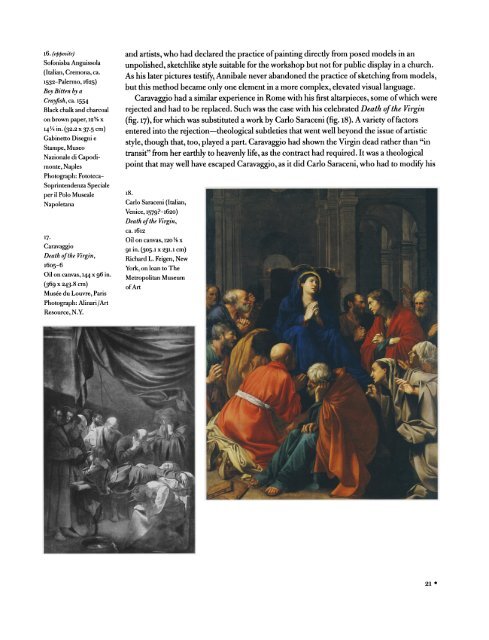GOING FOR BAROQUE Into the Bin - The Metropolitan Museum of Art
GOING FOR BAROQUE Into the Bin - The Metropolitan Museum of Art
GOING FOR BAROQUE Into the Bin - The Metropolitan Museum of Art
You also want an ePaper? Increase the reach of your titles
YUMPU automatically turns print PDFs into web optimized ePapers that Google loves.
l6. (opposite)<br />
S<strong>of</strong>onisba<br />
Anguissola<br />
(Italian, Cremona, ca.<br />
1532-Palermo, 1625)<br />
Boy Bitten<br />
Crayfish,<br />
Black<br />
by a<br />
ca. 1554<br />
chalk and charcoal<br />
on brown paper, 12% x<br />
14 ^ in. (32.2x37.5 cm)<br />
Gabinetto<br />
Stampe,<br />
Nazionale<br />
monte,<br />
Disegni<br />
Museo<br />
Naples<br />
Photograph:<br />
Soprintendenza<br />
per<br />
Napoletana<br />
17<br />
di Capodi<br />
e<br />
Fototeca<br />
il Polo Museale<br />
Sp?ciale<br />
Caravaggio<br />
Death <strong>of</strong> <strong>the</strong> Virgin,<br />
1605-6<br />
Oil on canvas, 144 x 96 in.<br />
(369 x 243.8 cm)<br />
Mus?e du Louvre, Paris<br />
and artists, who had declared <strong>the</strong> practice<br />
<strong>of</strong> painting directly<br />
from posed<br />
models in an<br />
unpolished,<br />
sketchlike<br />
style<br />
suitable for <strong>the</strong> workshop<br />
but not for public display<br />
in a church.<br />
As his later pictures testify,<br />
Annibale never abandoned <strong>the</strong> practice<br />
<strong>of</strong> sketching<br />
from models,<br />
but this method became one<br />
only<br />
element in a more<br />
complex,<br />
elevated visual<br />
language.<br />
Caravaggio<br />
had a similar<br />
experience<br />
in Rome with his first some altarpieces,<br />
<strong>of</strong> which were<br />
rejected and had to be<br />
replaced.<br />
Such was <strong>the</strong> case with his celebrated Death <strong>of</strong> <strong>the</strong> Virgin<br />
(fig. 17), for which was substituted a work by Carlo Saraceni (fig. 18). A variety<br />
<strong>of</strong> factors<br />
entered into <strong>the</strong> rejection?<strong>the</strong>ological<br />
subdeties that went well<br />
beyond<br />
<strong>the</strong> issue <strong>of</strong> artistic<br />
style, though that, too, a<br />
played part. Caravaggio<br />
had shown <strong>the</strong> Virgin<br />
dead ra<strong>the</strong>r than "in<br />
transit" from her<br />
earthly<br />
to heavenly life, as <strong>the</strong> contract had required.<br />
It was a <strong>the</strong>ological<br />
point<br />
that may well have as<br />
escaped Caravaggio,<br />
it did Carlo Saraceni, who had to modify<br />
his<br />
i8.<br />
Carlo<br />
Saraceni<br />
(Italian,<br />
Venice, 1579?-i62o)<br />
Death <strong>of</strong> <strong>the</strong> Virgin,<br />
ca. 1612<br />
Oil on canvas, 120 V% x<br />
91 in. (305.1x231.1 cm)<br />
Richard L. Feigen,<br />
New<br />
York,<br />
<strong>Metropolitan</strong><br />
<strong>of</strong> <strong>Art</strong><br />
on loan to <strong>The</strong><br />
<strong>Museum</strong><br />
Photograph: Alinari/<strong>Art</strong><br />
Resource, N.Y.<br />
21
















